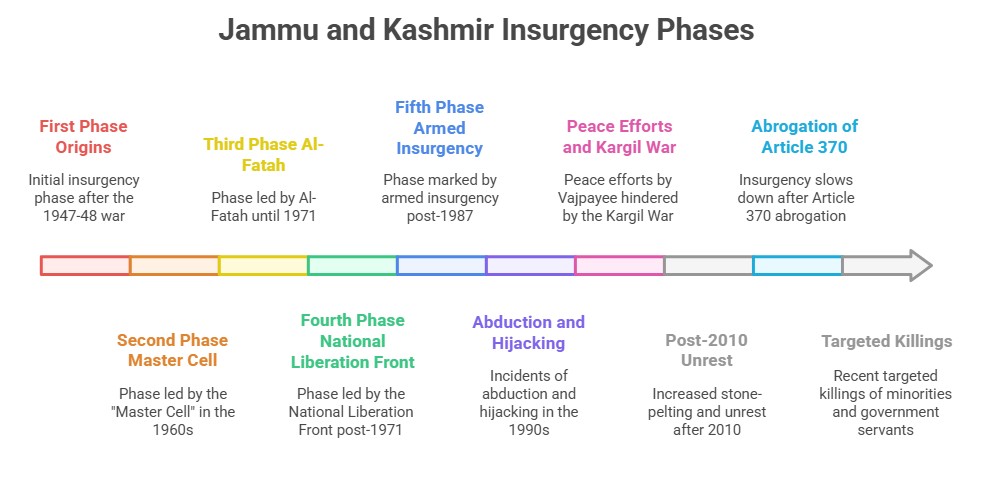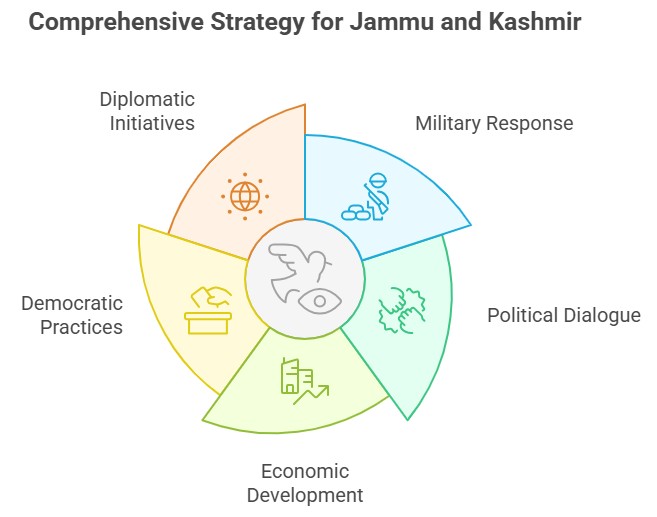The History of Jammu and Kashmir is marked by its rich cultural heritage, strategic significance, and complex political developments. From ancient dynasties to modern-day conflicts, the region has witnessed a unique blend of tradition, struggle, and transformation.
History of Jammu and Kashmir (J&K)

Pre-Independence Period
- After the decline of the Mughal Empire, Kashmir passed through Afghan, Sikh, and Dogra rule.
- In 1752, Kashmir was seized by the Afghan ruler Ahmed Shah Abdali.
- The Sikh ruler Ranjit Singh annexed Kashmir in 1819, ending the Muslim rule. The British Empire played a significant role in the region after the Sikh rule.
Instrument of Accession and Referendum
- In August 1947, Maharaja Hari Singh did not accede to either India or Pakistan, hoping for an independent state.
- The invasion of Kashmir by Pathan tribesmen and Pakistan Army led to the Maharaja seeking military help from India.
- The Maharaja acceded to India on October 26, 1947, by signing the Instrument of Accession and appointed Sheikh Abdullah as the head of the state's administration.
- The issue of Kashmir's accession to India is still a matter of dispute between India and Pakistan, under the agenda of the UN Security Council.
Constituent Assembly of Jammu & Kashmir
- The people of Jammu and Kashmir convened a Constituent Assembly in 1951, reaffirming the state's accession to India and finalizing the Constitution for the state.
- The Constitution states that Jammu and Kashmir are an integral part of the Union of India.
Shimla Agreement, 1972
- After the 1971 war with Pakistan, the Shimla Agreement was signed, establishing the Line of Control (LoC) as a permanent border between India and Pakistan.
- India's primary objective in Kashmir has been to maintain the status quo and convert the LoC into an international border.
Recent Attacks in Jammu and Kashmir
- Rise in terrorist activities: In 2022, Jammu and Kashmir witnessed a significant increase in terrorist activities compared to the corresponding period in 2021, although overall terrorist attacks have declined over the past three years.
- Militants killed: The security forces have neutralized 80 militants in 2022, compared to 54 in 2021.
- Casualties: As of January 2023, seven civilians have been killed and 23 injured in Jammu and Kashmir, with no casualties among security personnel.
Background: The Jammu and Kashmir Insurgency
- First phase: The Origins (1947-48)
- The insurgency in Jammu and Kashmir began after the India-Pakistan War of 1947-48.
- Small groups of covert operatives supported by Pakistan were responsible for initiating this phase.
- Second phase: The "Master Cell" Era (1960s-mid '60s)
- The second phase of the insurgency occurred between the 1960s and mid-'60s.
- The "Master Cell" led this phase, aiming to create conditions for a mass rebellion in Jammu and Kashmir.
- Third phase: The Al-Fatah Leadership (1960s-1971)
- The third phase took place between the 1960s and 1971 and was led by a group known as Al-Fatah.
- This phase concluded with the end of the 1971 war.
- Fourth phase: National Liberation Front (Post-1971 War)
- The fourth phase of the insurgency was led by the National Liberation Front after the 1971 war.
- They had limited institutional support from Pakistan.
- Fifth phase: Armed Insurgency (Post-1987)
- In the 1987 elections, the Jamaat-e-Islami and other Islamic groups formed the Muslim United Front (MUF), a pro-secessionist party that was expected to win the elections.
- However, the National Conference, led by Farooq Abdullah, came to power. This led to accusations of election rigging by MUF supporters.
- In 1995, four foreign tourists were abducted, and some were killed.
- In 1999, Pakistan-backed operatives hijacked Indian Airlines flight IC 814, leading the Indian government to release dangerous prisoners to secure the passengers' release.
- In the late 1990s, Indian Prime Minister AB Vajpayee initiated efforts to restore peace between India and Pakistan regarding Kashmir.
- The Kargil war, however, hindered these peace-building efforts.
- After 2010, incidents of stone-pelting increased, and the killing of terrorist Burhan Wani triggered months of unrest in Kashmir.
- Following the abrogation of Article 370, the insurgency slowed down due to counter-insurgency operations by the Army.
- In the past 2-3 years, terrorists have resorted to targeted killings of religious minorities, outsiders, and government servants.

Militancy in Jammu and Kashmir
Present Status
- The security situation in Jammu and Kashmir has deteriorated over the years, with increasing incidents of violence and terrorism.
- The government of India has implemented development-oriented programs, including infrastructure projects, skill development initiatives, and employment schemes.
- The recent revocation of Article 370 and 35A has changed the status of Jammu and Kashmir, with the state being reorganized into two separate union territories
Factors Contributing to Insurgency in Jammu and Kashmir
- Limited control of India: Jammu and Kashmir, previously enjoying special status under Article 370, had significant autonomy, resulting in the Indian government having restricted control over the state's affairs.
- Support from Pakistan: Pakistani intelligence agencies have been providing support, arms, and training to "mujahideen" militants operating in Jammu and Kashmir.
- Religious fanaticism: The insurgency in Jammu and Kashmir has been portrayed with a religious angle, as several religious leaders openly call for people to join the "religious war."
- Porous borders: The borders of Jammu and Kashmir have been porous, primarily due to unresolved territorial disputes, allowing militants to enter the region after receiving training in Pakistan.
- Draconian laws: Laws such as the Armed Forces Special Powers Act (AFSPA) and Public Safety Act (PSA) have led to discontentment against the Indian administration, contributing to the insurgency.
Reasons for the Increase in Terrorist Attacks
- Infiltration: A majority of terror attacks are carried out by terrorists infiltrating through the porous Line of Control (LoC), obtaining arms and training from camps in Pakistan.
- Lone-wolf model: Recent trends indicate an increase in lone-wolf attacks without the existence of sophisticated modules, making it difficult for security agencies to predict new attacks.
- Access to weapons: Terrorists in Jammu and Kashmir are provided weapons by their handlers using drones, posing a major challenge for security agencies due to the easy accessibility of weapons.
- Public sympathy: Perpetrators can easily hide after committing a crime due to public sympathy, making it challenging for security agencies to track them down.
- Insider support: Terrorists receive support from insiders who provide them with secret information about potential targets, as observed during targeted killings of minorities.
Government Approach towards Jammu and Kashmir Militancy
- Military Response against Violence and Infiltration
- Employing military forces to combat violence and prevent infiltration across border areas and coordinating operations of the Army, police, and paramilitary forces through a Unified Headquarters.
- Utilizing paramilitary forces such as the Border Security Force, Central Reserve Police Force, and Special Forces as well as establishing the Rashtriya Rifles (RR) as a specialized force to counter insurgency.
- Focusing on preventing the infiltration of insurgents from launch pads and training camps in Pakistan by fortifying the Line of Control (LOC) and the International Border.
- Political Dialogue and Negotiations
- Engaging in political dialogue and negotiations with groups that have renounced violence.
- Pursuing a dual strategy of holding dialogues with moderate groups since 1997, with increased momentum after the 9/11 attacks.
- Working towards a peaceful resolution of the Kashmir issue through constructive discussions.
- Economic and Social Development
- Implementing measures for economic and social development to enhance the living conditions and employment opportunities of the local population.
- Initiating reconstruction plans and developmental projects, with significant financial outlays, focusing on infrastructure, power, transport, renewable energy, urban development, railways, roadways, health, tourism, welfare of displaced people, and flood relief.
- Development of Democratic Practices
- Upholding democratic practices despite the region's turmoil and instability and regularly conducting assembly and parliament elections in the state of Jammu & Kashmir.
- Notable increase in voter participation during each election, reflecting the people's desire for peace and harmony.
- Diplomatic Initiatives
- Undertaking diplomatic initiatives to foster peace and stability in the region.
- Engaging in confidence-building measures with Pakistan and international counter-terrorism cooperation with friendly countries.
- Strengthening India's position internationally by highlighting Pakistan-based militant group attacks on the J&K legislative Assembly and Indian Parliament in 2002.
- Actively pursuing dialogue with Pakistan on various issues, including the Kashmir dispute.
- Engaging in talks with moderate groups within Kashmir to seek a peaceful resolution to the issue.

Way Forward
- Public outreach: While security agencies and the government have implemented goodwill measures, additional programs addressing the fundamental issues faced by the valley's residents, such as infrastructure, education, and livelihood, are necessary.
- De-radicalization, Strengthening security apparatus:
- Financial sanctions: Terror groups posing as NGOs should be sanctioned to sever their access to foreign funding.
Conclusion
Bridging the divide between Kashmir and India requires effective narratives. Recent developments, including the rise of new militancy and changes in Kashmir's special status, have widened this divide. The Indian state and armed forces aim to enhance their nation-building narrative through social media initiatives. However, significant work remains to overcome alienation and strengthen the narrative-building efforts. Seizing the absence of armed conflict, New Delhi should strive to bring lasting peace and closer ties to the region.













